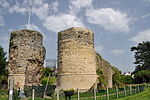St Mary's Church, Bungay
BungayChurch of England church buildings in SuffolkChurches preserved by the Churches Conservation TrustEnglish Gothic architecture in SuffolkGrade I listed churches in Suffolk

St Mary's Church is a redundant Anglican church in the town of Bungay, Suffolk, England. The church and the ruins of the adjacent priory are recorded in the National Heritage List for England as a designated Grade I listed building, and are under the care of the Churches Conservation Trust. The church stands in the centre of the town on St Mary's Street, the A144 road.
Excerpt from the Wikipedia article St Mary's Church, Bungay (License: CC BY-SA 3.0, Authors, Images).St Mary's Church, Bungay
Trinity Street, East Suffolk
Geographical coordinates (GPS) Address Nearby Places Show on map
Geographical coordinates (GPS)
| Latitude | Longitude |
|---|---|
| N 52.4556 ° | E 1.4379 ° |
Address
Trinity Street
NR35 1EQ East Suffolk
England, United Kingdom
Open on Google Maps









